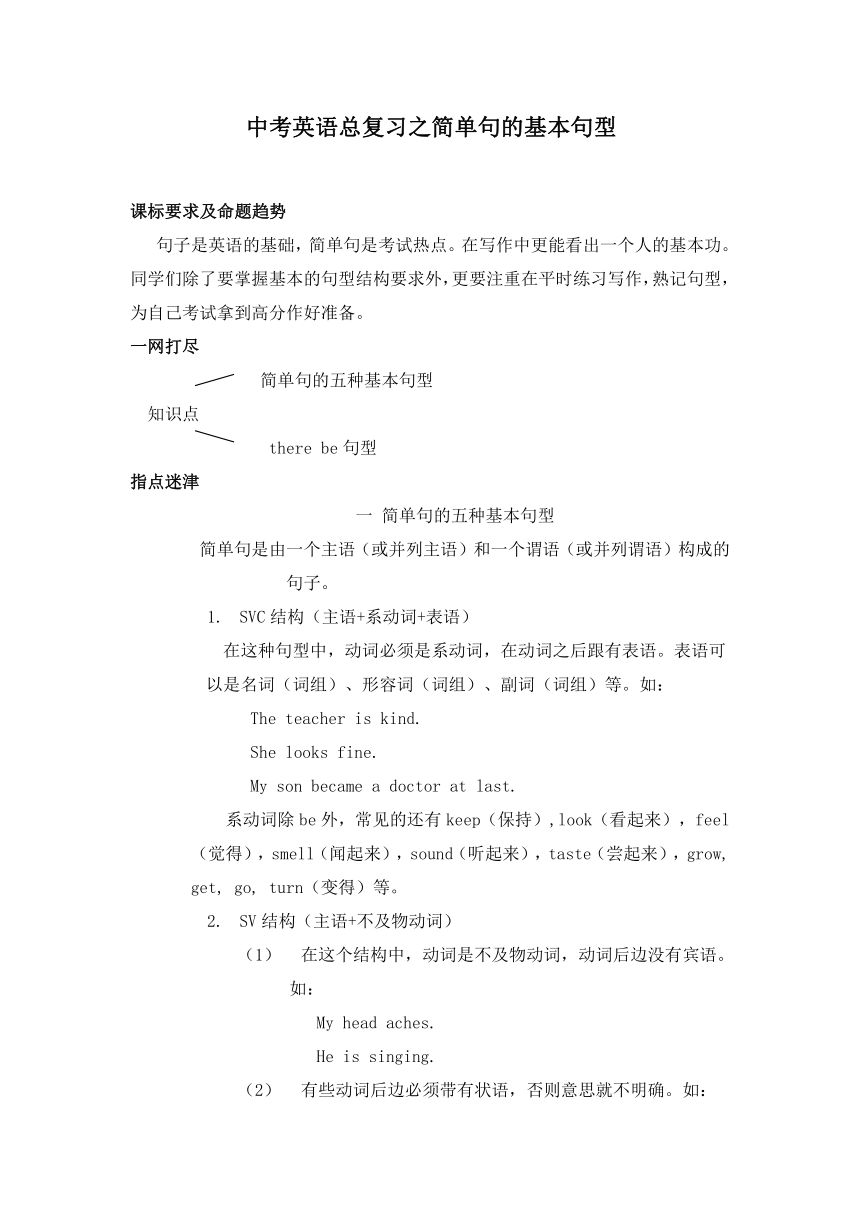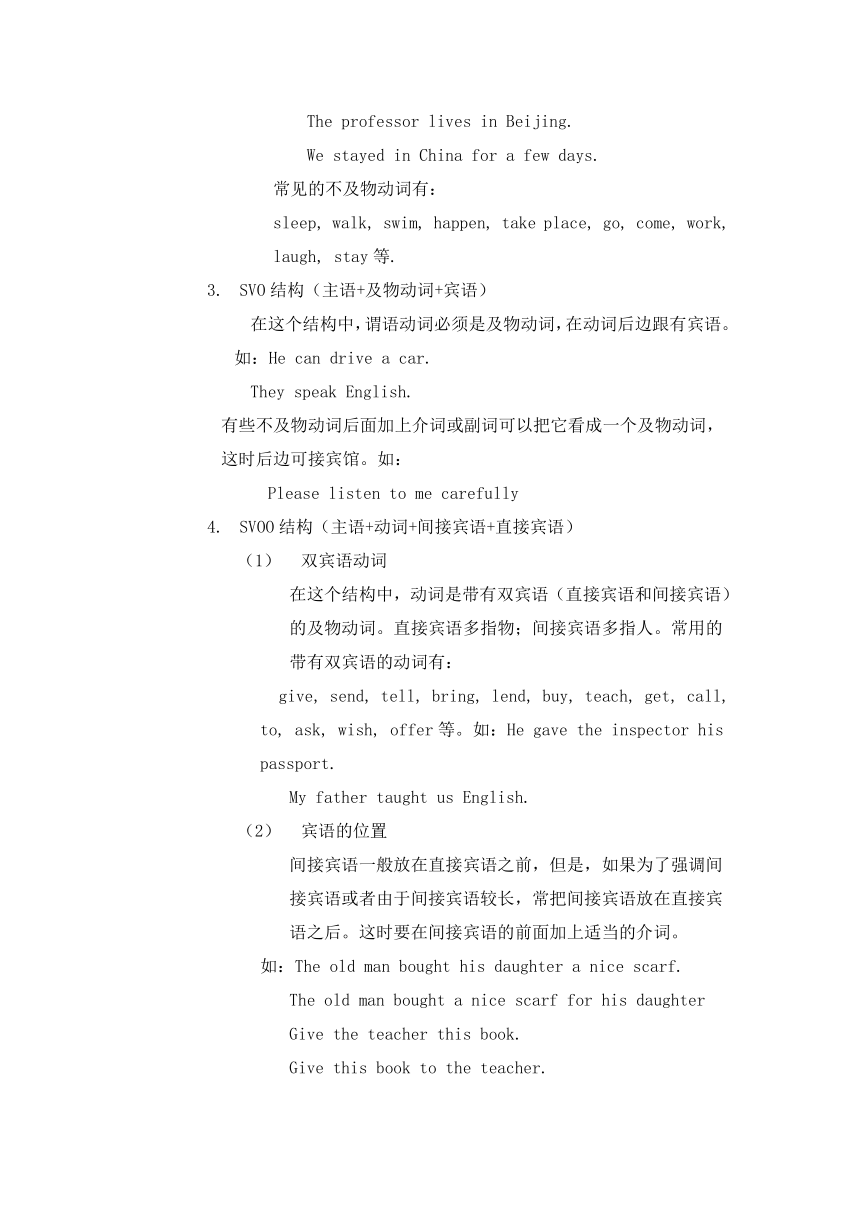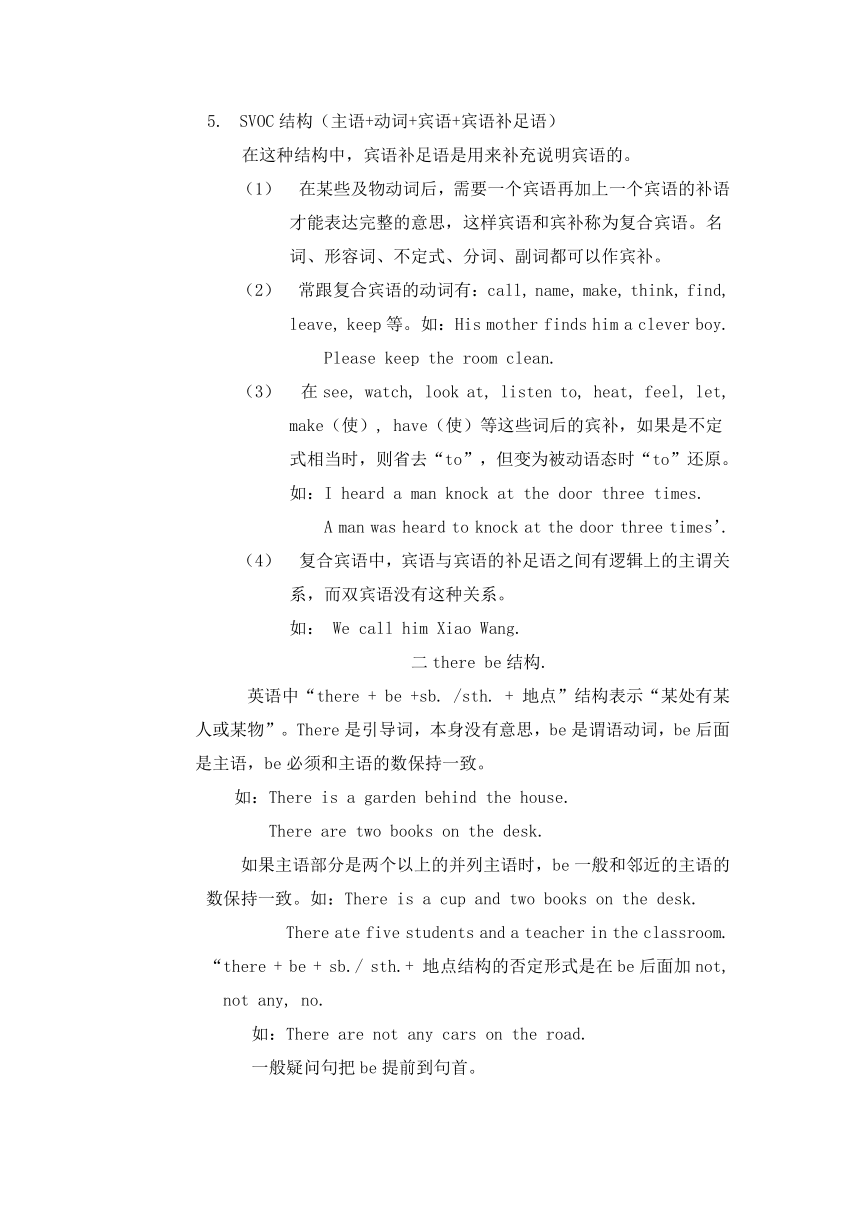中考英语总复习之简单句的基本句型[下学期]
文档属性
| 名称 | 中考英语总复习之简单句的基本句型[下学期] |  | |
| 格式 | rar | ||
| 文件大小 | 8.9KB | ||
| 资源类型 | 教案 | ||
| 版本资源 | 通用版 | ||
| 科目 | 英语 | ||
| 更新时间 | 2008-04-06 23:32:00 | ||
图片预览



文档简介
中考英语总复习之简单句的基本句型
课标要求及命题趋势
句子是英语的基础,简单句是考试热点。在写作中更能看出一个人的基本功。同学们除了要掌握基本的句型结构要求外,更要注重在平时练习写作,熟记句型,为自己考试拿到高分作好准备。
一网打尽
简单句的五种基本句型
知识点
there be句型
指点迷津
一 简单句的五种基本句型
简单句是由一个主语(或并列主语)和一个谓语(或并列谓语)构成的句子。
1. SVC结构(主语+系动词+表语)
在这种句型中,动词必须是系动词,在动词之后跟有表语。表语可以是名词(词组)、形容词(词组)、副词(词组)等。如:
The teacher is kind.
She looks fine.
My son became a doctor at last.
系动词除be外,常见的还有keep(保持),look(看起来),feel(觉得),smell(闻起来),sound(听起来),taste(尝起来),grow, get, go, turn(变得)等。
2. SV结构(主语+不及物动词)
(1) 在这个结构中,动词是不及物动词,动词后边没有宾语。如:
My head aches.
He is singing.
(2) 有些动词后边必须带有状语,否则意思就不明确。如:
The professor lives in Beijing.
We stayed in China for a few days.
常见的不及物动词有:
sleep, walk, swim, happen, take place, go, come, work, laugh, stay等.
3. SVO结构(主语+及物动词+宾语)
在这个结构中,谓语动词必须是及物动词,在动词后边跟有宾语。
如:He can drive a car.
They speak English.
有些不及物动词后面加上介词或副词可以把它看成一个及物动词,这时后边可接宾馆。如:
Please listen to me carefully
4. SVOO结构(主语+动词+间接宾语+直接宾语)
(1) 双宾语动词
在这个结构中,动词是带有双宾语(直接宾语和间接宾语)的及物动词。直接宾语多指物;间接宾语多指人。常用的带有双宾语的动词有:
give, send, tell, bring, lend, buy, teach, get, call, to, ask, wish, offer等。如:He gave the inspector his passport.
My father taught us English.
(2) 宾语的位置
间接宾语一般放在直接宾语之前,但是,如果为了强调间接宾语或者由于间接宾语较长,常把间接宾语放在直接宾语之后。这时要在间接宾语的前面加上适当的介词。
如:The old man bought his daughter a nice scarf.
The old man bought a nice scarf for his daughter
Give the teacher this book.
Give this book to the teacher.
5. SVOC结构(主语+动词+宾语+宾语补足语)
在这种结构中,宾语补足语是用来补充说明宾语的。
(1) 在某些及物动词后,需要一个宾语再加上一个宾语的补语才能表达完整的意思,这样宾语和宾补称为复合宾语。名词、形容词、不定式、分词、副词都可以作宾补。
(2) 常跟复合宾语的动词有:call, name, make, think, find, leave, keep等。如:His mother finds him a clever boy.
Please keep the room clean.
(3) 在see, watch, look at, listen to, heat, feel, let, make(使), have(使)等这些词后的宾补,如果是不定式相当时,则省去“to”,但变为被动语态时“to”还原。
如:I heard a man knock at the door three times.
A man was heard to knock at the door three times’.
(4) 复合宾语中,宾语与宾语的补足语之间有逻辑上的主谓关系,而双宾语没有这种关系。
如: We call him Xiao Wang.
二there be结构.
英语中“there + be +sb. /sth. + 地点”结构表示“某处有某人或某物”。There是引导词,本身没有意思,be是谓语动词,be后面是主语,be必须和主语的数保持一致。
如:There is a garden behind the house.
There are two books on the desk.
如果主语部分是两个以上的并列主语时,be一般和邻近的主语的数保持一致。如:There is a cup and two books on the desk.
There ate five students and a teacher in the classroom.
“there + be + sb./ sth.+ 地点结构的否定形式是在be后面加not, not any, no.
如:There are not any cars on the road.
一般疑问句把be提前到句首。
如: Are there any cars on the road
此结构中的be也可以用live,lie等不及物动词。
There lives an old man.
讲解面对面
例1. ---There ______ a concert this evening. (2005, 徐州)
--- Yeah. Exciting news.
A. are going to be B. is going to be
C. is going to have D. will have
思维导航:此题考查there be句型的将来时。
解答:there be句型中不能出现have,所以C和D错误;又因为句中的a可判断为单数。
所以选B。
拓展延伸:there be句型除要注意“就近原则”外,还要注意与have的区别。
例2. Tom was so careless that he didn’t find the mistakes in his test paper. (改为简单句) (2005, 岳阳)
Tom was ______ careless ______ find the mistakes in his test paper.
思维导航:此题考查简单句与复合句的相互转换。
解答:原句是一个复合句,要该成简单句,除去掉关系词外,还得符合简单句的要求,即:SVC结构。此处的表语是由一个副词短语充当的。所以答案应该是too…to.
拓展延伸:简单句与复合句的相互转换,除要牢记基本结构外,同义 词组的记忆也有助于解题。
例3. 许多你们喜爱的明星来自于台湾。(2005,济南)
Many of your favorite stars ______ ______ Taiwan.
思维导航:此题考查SVC及SV结构的综合运用。
解答:从句意可知,答案有两个:come from 或be from.。用前者,属于SV结构;用后者,属于SVC结构。所以答案也有两个:come from或are from.
拓展延伸:在具体使用中,只要能表达清楚意思,语法也正确,就不要去费神考虑该用哪种结构了。
大展身手
( ) 1. The fruit tastes ______.
A. nice B. well C. fine D. terribly.
( ) 2.. We should keep ______ in the reading-room.
A. quiet B. quietly C. quite D. quietly
( ) 3. The room is ______ for fifty students.
A. as big B. big enough
C. enough big D. big as
( ) 4. Will you ______ it again I didn’t ______ you.
A. speak, listen B. say, hear
C. talk, hear D. tell, listen
( ) 5. She is Nancy. She teaches ______ English.
A. our B. us C. we D. ourselves
( ) 6. Too much work usually makes them ______ tired.
A. to feel B. feels C. feeling D. feel
( ) 7. --- She tried hard to stop her husband from smoking, didn’t she
--- Yes. But she ______.
A. failed B. fell C. made in D. got it
( ) 8. Lily writes ______ in her class.
A. more careful B. more carefully
C. most careful D. most carefully
( ) 9. ______ eat a lot of rice and fish.
A. Japaneses B. Japanese
C. Japan people D. People of Japanese
( ) 10. Tell him ______ the teacher and _______ the window.
A. to listen to, not look out of
B. to listen to, not to look out
C. to listen to, not to look out of
D. listen to, don’t look out of
课标要求及命题趋势
句子是英语的基础,简单句是考试热点。在写作中更能看出一个人的基本功。同学们除了要掌握基本的句型结构要求外,更要注重在平时练习写作,熟记句型,为自己考试拿到高分作好准备。
一网打尽
简单句的五种基本句型
知识点
there be句型
指点迷津
一 简单句的五种基本句型
简单句是由一个主语(或并列主语)和一个谓语(或并列谓语)构成的句子。
1. SVC结构(主语+系动词+表语)
在这种句型中,动词必须是系动词,在动词之后跟有表语。表语可以是名词(词组)、形容词(词组)、副词(词组)等。如:
The teacher is kind.
She looks fine.
My son became a doctor at last.
系动词除be外,常见的还有keep(保持),look(看起来),feel(觉得),smell(闻起来),sound(听起来),taste(尝起来),grow, get, go, turn(变得)等。
2. SV结构(主语+不及物动词)
(1) 在这个结构中,动词是不及物动词,动词后边没有宾语。如:
My head aches.
He is singing.
(2) 有些动词后边必须带有状语,否则意思就不明确。如:
The professor lives in Beijing.
We stayed in China for a few days.
常见的不及物动词有:
sleep, walk, swim, happen, take place, go, come, work, laugh, stay等.
3. SVO结构(主语+及物动词+宾语)
在这个结构中,谓语动词必须是及物动词,在动词后边跟有宾语。
如:He can drive a car.
They speak English.
有些不及物动词后面加上介词或副词可以把它看成一个及物动词,这时后边可接宾馆。如:
Please listen to me carefully
4. SVOO结构(主语+动词+间接宾语+直接宾语)
(1) 双宾语动词
在这个结构中,动词是带有双宾语(直接宾语和间接宾语)的及物动词。直接宾语多指物;间接宾语多指人。常用的带有双宾语的动词有:
give, send, tell, bring, lend, buy, teach, get, call, to, ask, wish, offer等。如:He gave the inspector his passport.
My father taught us English.
(2) 宾语的位置
间接宾语一般放在直接宾语之前,但是,如果为了强调间接宾语或者由于间接宾语较长,常把间接宾语放在直接宾语之后。这时要在间接宾语的前面加上适当的介词。
如:The old man bought his daughter a nice scarf.
The old man bought a nice scarf for his daughter
Give the teacher this book.
Give this book to the teacher.
5. SVOC结构(主语+动词+宾语+宾语补足语)
在这种结构中,宾语补足语是用来补充说明宾语的。
(1) 在某些及物动词后,需要一个宾语再加上一个宾语的补语才能表达完整的意思,这样宾语和宾补称为复合宾语。名词、形容词、不定式、分词、副词都可以作宾补。
(2) 常跟复合宾语的动词有:call, name, make, think, find, leave, keep等。如:His mother finds him a clever boy.
Please keep the room clean.
(3) 在see, watch, look at, listen to, heat, feel, let, make(使), have(使)等这些词后的宾补,如果是不定式相当时,则省去“to”,但变为被动语态时“to”还原。
如:I heard a man knock at the door three times.
A man was heard to knock at the door three times’.
(4) 复合宾语中,宾语与宾语的补足语之间有逻辑上的主谓关系,而双宾语没有这种关系。
如: We call him Xiao Wang.
二there be结构.
英语中“there + be +sb. /sth. + 地点”结构表示“某处有某人或某物”。There是引导词,本身没有意思,be是谓语动词,be后面是主语,be必须和主语的数保持一致。
如:There is a garden behind the house.
There are two books on the desk.
如果主语部分是两个以上的并列主语时,be一般和邻近的主语的数保持一致。如:There is a cup and two books on the desk.
There ate five students and a teacher in the classroom.
“there + be + sb./ sth.+ 地点结构的否定形式是在be后面加not, not any, no.
如:There are not any cars on the road.
一般疑问句把be提前到句首。
如: Are there any cars on the road
此结构中的be也可以用live,lie等不及物动词。
There lives an old man.
讲解面对面
例1. ---There ______ a concert this evening. (2005, 徐州)
--- Yeah. Exciting news.
A. are going to be B. is going to be
C. is going to have D. will have
思维导航:此题考查there be句型的将来时。
解答:there be句型中不能出现have,所以C和D错误;又因为句中的a可判断为单数。
所以选B。
拓展延伸:there be句型除要注意“就近原则”外,还要注意与have的区别。
例2. Tom was so careless that he didn’t find the mistakes in his test paper. (改为简单句) (2005, 岳阳)
Tom was ______ careless ______ find the mistakes in his test paper.
思维导航:此题考查简单句与复合句的相互转换。
解答:原句是一个复合句,要该成简单句,除去掉关系词外,还得符合简单句的要求,即:SVC结构。此处的表语是由一个副词短语充当的。所以答案应该是too…to.
拓展延伸:简单句与复合句的相互转换,除要牢记基本结构外,同义 词组的记忆也有助于解题。
例3. 许多你们喜爱的明星来自于台湾。(2005,济南)
Many of your favorite stars ______ ______ Taiwan.
思维导航:此题考查SVC及SV结构的综合运用。
解答:从句意可知,答案有两个:come from 或be from.。用前者,属于SV结构;用后者,属于SVC结构。所以答案也有两个:come from或are from.
拓展延伸:在具体使用中,只要能表达清楚意思,语法也正确,就不要去费神考虑该用哪种结构了。
大展身手
( ) 1. The fruit tastes ______.
A. nice B. well C. fine D. terribly.
( ) 2.. We should keep ______ in the reading-room.
A. quiet B. quietly C. quite D. quietly
( ) 3. The room is ______ for fifty students.
A. as big B. big enough
C. enough big D. big as
( ) 4. Will you ______ it again I didn’t ______ you.
A. speak, listen B. say, hear
C. talk, hear D. tell, listen
( ) 5. She is Nancy. She teaches ______ English.
A. our B. us C. we D. ourselves
( ) 6. Too much work usually makes them ______ tired.
A. to feel B. feels C. feeling D. feel
( ) 7. --- She tried hard to stop her husband from smoking, didn’t she
--- Yes. But she ______.
A. failed B. fell C. made in D. got it
( ) 8. Lily writes ______ in her class.
A. more careful B. more carefully
C. most careful D. most carefully
( ) 9. ______ eat a lot of rice and fish.
A. Japaneses B. Japanese
C. Japan people D. People of Japanese
( ) 10. Tell him ______ the teacher and _______ the window.
A. to listen to, not look out of
B. to listen to, not to look out
C. to listen to, not to look out of
D. listen to, don’t look out of
同课章节目录
- 词法
- 名词
- 动词和动词短语
- 动词语态
- 动词时态
- 助动词和情态动词
- 非谓语动词
- 冠词
- 代词
- 数词和量词
- 形容词副词及其比较等级
- 介词和介词短语
- 连词和感叹词
- 构词法
- 相似、相近词比较
- 句法
- 陈述句
- 一般疑问句和否定疑问句
- 特殊疑问句及选择疑问句
- 反意疑问句
- 存在句(There be句型)
- 宾语从句
- 定语从句
- 状语从句
- 主谓一致问题
- 简单句
- 并列句
- 复合句
- 主谓一致
- 主、表语从句
- 名词性从句
- 直接引语和间接引语
- 虚拟语气
- 感叹句
- 强调句
- 倒装句
- 祈使句
- 句子的成分
- 句子的分类
- 题型专区
- 单项选择部分
- 易错题
- 完形填空
- 阅读理解
- 词汇练习
- 听说训练
- 句型转换
- 补全对话
- 短文改错
- 翻译
- 书面表达
- 任务型阅读
- 语法填空
- 其他资料
